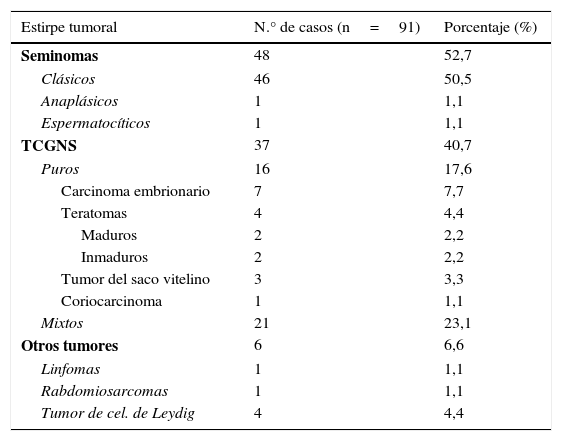Realizar un análisis descriptivo en pacientes diagnosticados de cáncer testicular primario y valorar posibles factores predictores de recidiva tumoral, con el fin de establecer seguimientos individualizados.
Material y métodosEstudio longitudinal retrospectivo con una cohorte de 91 pacientes intervenidos de orquiectomía radical por tumor testicular primario entre enero del 2004 y diciembre del 2014. Las variables analizadas fueron: motivo de consulta, características ecográficas, marcadores tumorales (AFP, LDH Y β-HCG), estadio tumoral, anatomía patológica, tratamiento y presencia de recaída. Para el estudio de la recaída se han realizado una curva de Kaplan-Meier y una regresión logística para valorar factores predictores.
ResultadosLa edad media fue de 31,8±10,4 años. El motivo de consulta más frecuente fue masa indolora (71,1%), seguido de dolor testicular (24,4%). En la ecografía la mayoría presentaban una masa única (78,3%) y heterogénea (85,4%). El 71,4% de los casos se encontraban en estadio i, el 24,2% en estadio ii y 4,4% en estadio iii. En 55 pacientes se realizó únicamente orquiectomía radical, en 34 se asoció quimioterapia y en 2 se aplicó radioterapia. Durante el tiempo de seguimiento han recaído 14 pacientes (15,38%) y ha habido un fallecimiento. De las 14 recaídas, 9 ocurrieron durante el primer año. El único factor predictor de recidiva detectado fue un nivel elevado de β-HCG.
ConclusiónEl cáncer testicular suele diagnosticarse en un estadio localizado y tiene altas tasas de curación. Las recidivas aparecen habitualmente en los primeros años de seguimiento y el único factor predictor hallado en nuestra experiencia es una β-HCG elevada.
To perform a descriptive study in patients diagnosed with testicular cancer and analyze the potential risk factors in order to establish an individualized follow up.
Material and methodsWe performed a longitudinal retrospective study from January 2004 to December 2014 in 91 patients with testicular cancer. They underwent to radical orchiectomy due to testicular cancer at our center. We analyzed the reason for consultation, ultrasound characteristics, tumor markers (AFP, LDH and bHGC), tumor stage, pathology, treatment and relapses during the follow up. To analyze the risk factors, we used the Kaplan Meier curve and logistic regression.
ResultsThe mean age was 31.8±10.4. The most frequent reason for consultation was painless lump (71.1%), following by testicular pain (24.4%). The main scrotal ultrasound feature was solitary tumor (78.3%) and heterogeneous (85.4%). The stage I was present in 71.4% of the cases, 24.2% were stage II and 4.4% were stage III. Regarding the treatment, 55 patients underwent to radical orchiectomy, 34 received adjuvant chemotherapy and 2 adjuvant radiotherapy. 14 (15.38%) patients had a relapse and one patient died from testicular cancer. Nine relapses from fourteen have been during the first year after the initial treatment. We only found that a bHCG high level is a predictive factor of relapse.
ConclusionTesticular cancer is diagnosed in an early stage and it has a high cure rate. The relapse has been during the first year of follow up. In our experience, we identified bHCG high level as predictor factor.






